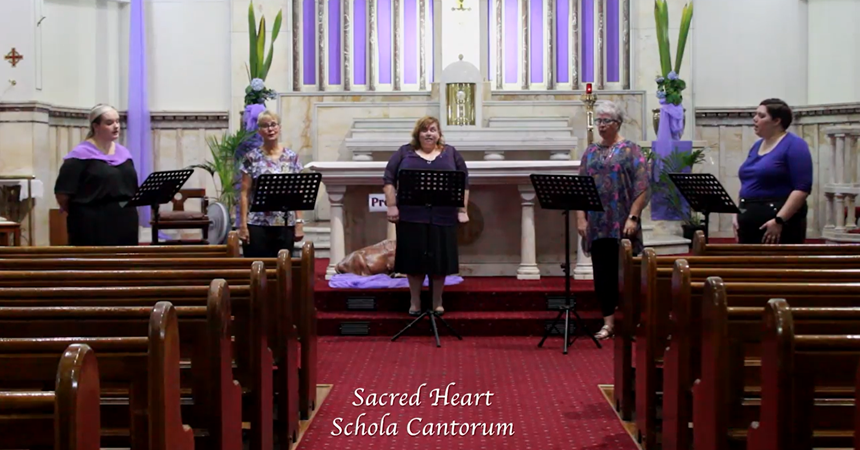For many people, 2020 has been a “pile of manure” year. Drought, fires, floods, and COVID-19. It’s a year we won’t easily forget. Likely our lives are forever changed.
Yet, God indeed blessed me with a pony. With the rare luxury of time on my hands, I enrolled in an online course on Gregorian Chant, offered by Fr Anthony Ruff from Saint John’s Abbey in Minnesota, USA.
My love affair with Gregorian Chant began in 2010 while preparing my choir for a tour of Italy. The choir, from my then parish of Sacred Heart in Shawnee (a suburb of Kansas City) was invited to sing for Sunday evening Mass at St Peter’s Basilica in Rome on Trinity Sunday. Required to submit my song list to the Director of Music at the Vatican, I sent in a varied program, including the hymn "Holy, Holy, Holy, Lord God Almighty” (it was Trinity Sunday, after all). Much to my surprise the hymn was rejected. I was stunned! It was then (and only then) that I learned that hymns, per se, are Protestant. The great music of the Catholic Church is chant. A wonderful journey of learning and love began with that rejection. However, it’s only this year that I have been able to take a course in Gregorian Chant and with one of the world’s leading scholars in the subject.
Scholar, musician, and generally lovely person, Fr Anthony Ruff, OSB, opened my eyes to a wonderful world of chant and chanting. It truly is glorious! Fr Anthony is also Editor of the blog “Pray Tell” (praytellblog.com) and in July he posted guidance on how a Sunday Mass might work when the congregation cannot sing. Following his lead, particularly the notion that “although only cantors can sing, we still want the liturgy to be as festive and participative as possible”, I established a pattern at Sacred Heart Cathedral, as follows:
- Entrance antiphon: The choir chanted the Introit (entrance antiphon) of the day in English, using Simple English Propers by Adam Bartlett (available for free at https://musicasacra.com/additional-publications/sep/). The congregation then spoke two or three psalm verses and the doxology (Glory be to the Father…).
- We spoke the Penitential Rite and the Gloria.
- Responsorial Psalm: The congregation recited the refrain following a rhythm carefully established by the cantor and accompanied by simple chords on piano. The cantor then sang the psalm verses.
- Alleluia: The choir sang the Alleluia and the congregation spoke the verse. The trick (and the joy) was finding a lovely new Alleluia that people didn’t know. We very much enjoyed Marty Haugen’s Alleluia from the Mass of Creation. After a few weeks people began to catch on. We’ve now changed to a lovely Advent Gospel Acclamation arranged by Paul M. French (based on a 16th Century French Carol and available from GIA (https://www.giamusic.com/store/resource/advent-gospel-acclamations-print-005746).
- Mass parts: all spoken.
- Gifts and Communion: Herein lay another challenge! We had to pick music the congregation would not know by heart, lest they sing along (which happened more than once). The music had to be appealing and prayerful but not too well known. I think we had mixed success. Last week I used “My Soul in Stillness Waits” (by Marty Haugen) and again had the congregation speak the refrain in rhythm. It was surprisingly successful and quite rewarding.
- The dismissal was rather fun as I got to play some lovely organ music. There seemed little point having people stand and listen to the choir sing. And there’s always been a bit of a question mark in my mind around the dismissal. The celebrant says: “Go in peace to love and serve the Lord” but hang on, just wait and sing the last hymn. I rather liked the movement of people going once they were sent forth.
These changes to the usual way we do music for the liturgy have really stretched me to re-think our role as musicians. In general, congregations at Sacred Heart Cathedral have really embraced taking part in the Mass by speaking lyrics that would normally be sung. After cantoring last Saturday evening, Sr Jeannine said, “the congregation has found its voice!” So, what happens now? Will they lose that voice now singing is back? Vocal cords unstretched may take some time to limber!
As you might imagine, planning for Christmas has been yet another challenge. Until yesterday, we could only plan to have five individuals singing at Mass. All that careful planning is now thrown to the wind as the restrictions are lifting somewhat. I tend to be a fly-by-the-seat-of-my-pants kinda gal, but this month has been a bit much even for me!
When planning for Christmas Masses, I usually try to use music I think everyone can sing. Our usual repertoire is O Come All Ye Faithful, Joy to the World, Away in a Manger, Silent Night, and Hark! The Herald Angels Sing. Who doesn’t love those songs?! But in trying to keep congregations safe, I’ve had to rethink those musical choices. It’s a very tricky balance to find songs that move the heart but not the lips!
And so we formed ‘Sacred Heart Schola Cantorum’, a five-voice ensemble singing acapella (unaccompanied) chant. The group will debut on Christmas Eve at 7pm Mass. Here’s a little preview. The first piece is Hodie Christus Natus Est (Today, Christ is born), which dates from 900AD—yes, over 1000 years old! The second is Puer Natus in Bethlehem (A Child is Born in Bethlehem). I do hope you enjoy them!

